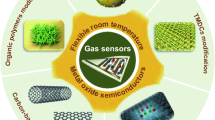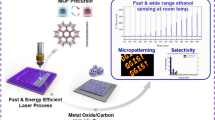Abstract
Nowadays, a good deal of research is focusing on the development of new analytical procedures for detection of hazardous agents, such as bacteria, harmful pollutants, toxic vapors, and many others. The majority of the research is aimed at developing new sensors and analytical equipment. This paper demonstrates a simple construction of an ammonia sensor based on commercially available electronic connectors with active elements from polyaniline. The main goal of this research is to present the simplicity of sensor manufacturing, without the need for advanced apparatus such as electropolymerization or electrospinning set-up. The active element of the proposed sensor is composed of polyaniline synthesized in situ on the surface of conductive glue. The layer of the conductive glue is a key element in this sensor as it protects the metallic pin against destruction during in situ synthesis of polyaniline (acidic and oxidizing conditions).
Similar content being viewed by others

References
Brzózka Z., Mikrobioanalityka, Oficyna Wydawnicza Politechniki Warszawskiej, Warszawa, 2009.
Rodriguez-Mozaz S., López De Alda M.J., Marco M.P., Barcelo D., Talanta, 65 (2005), 291.
Bloor D., Movaghar B., IEEE Proceedings, 130 (1983), 225.
Manju G., Asha C., Malhotra B.D., Biosensors and Bioelectronics, 17 (2002), 345.
Stęplewska U., Maćkowiak K., Kuleta P., Przemysł Spożywczy, 9 (2007), 18.
Stęplewska U., Maćkowiak K., Kuleta P., Technika Chłodnicza i Klimatyzacyjna, 5 (2007), 211.
Manigandan S., Jain A., Majumder S., Ganguly S., Kargupta K., Sensors and Actuators B: Chemical, 133 (2008), 187.
Crowley K., O’Malley E., Morrin A., Smyth M., Killard A., Analyst, 133 (2008), 391.
Laska J., Widlarz J., Polymer, 46 (2005), 1485.
Wardenecki W. Namieśnik J., Nowe horyzonty i wyzwania w analityce i monitoringu środowiskowym, Centrum Doskonałości Analityki i Monitoringu Środowiskowego (CEEAM), 2003.
Taka T., Synthetic Metals, 57 (1993), 5014.
Polska Norma PN-71/Z-04041, Oznaczanie zawartości amoniaku w powietrzu.
Trojanowicz M., Krawczyński T., Zmorzyńska M., Campanella L., Electroanalysis, 9 (1997), 1062.
Zhang L. Wan M., Advanced Functional Materials, 13 (2003), 815.
Yang Ch., Chih Y., Cheng H., Chen Ch., Polymer, 46 (2005), 10688.
Konyushenko E.N., Stejskal J., Šeděnková I., Trchov Á M., Sapurina I., Cieslar M., Prokeš J., Polymer International, 55 (2006), 31.
Author information
Authors and Affiliations
Corresponding author
About this article
Cite this article
Dobroczyńska, J.I., Grabas, K. An ammonia sensor based on in situ-synthesized polyaniline nanostructures. Mater Sci-Pol 31, 95–100 (2013). https://doi.org/10.2478/s13536-012-0076-2
Received:
Accepted:
Published:
Issue Date:
DOI: https://doi.org/10.2478/s13536-012-0076-2



